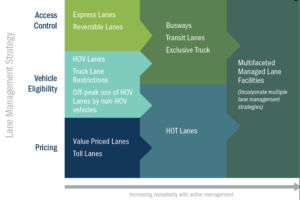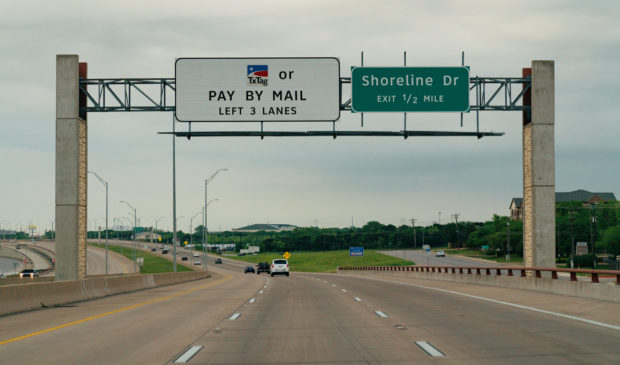Tolls or no tolls? City and state preferences differ for new I-35 lanes
Friday, April 2, 2021 by
Jonathan Lee The city of Austin, among other local stakeholders, is at odds with the Texas Department of Transportation and state leaders like Gov. Greg Abbott over the type of managed lanes in TxDOT’s I-35 Capital Express Project.
Despite lobbying by the city for variable toll lanes like those on MoPac Expressway, TxDOT remains intent on non-tolled high-occupancy-vehicle (HOV) lanes.
The multibillion-dollar project plans to add two HOV lanes in each direction along the eight-mile stretch between State Highway 71 and U.S. Highway 290. The four existing general-purpose lanes in each direction would move below grade. Some preliminary design alternatives show underground HOV lanes. The project is currently in the public engagement and environmental review phase, which means a final design won’t be ready until 2023.
Originally, the plans included tolled lanes. But in 2017 Abbott promised that no toll lanes would be included in the project – or in any other projects in Texas.
Eric Bollich, assistant director of the Austin Transportation Department, confirmed to the Urban Transportation Commission Tuesday that is still the case. “As of now, TxDOT has told us that it will be two managed lanes in each direction – not tolled.”
The issue is one of many discrepancies between city and state preferences for the project. City Council recently outlined the city’s goals in a resolution and a series of letters.
In a letter to TxDOT, Assistant City Manager Gina Fiandaca outlined two main arguments for toll lanes: 1) they’re less prone to congestion, allowing them to move more people; 2) they have the potential to decrease the project’s physical footprint.
“Prior traffic studies conducted during the TxDOT I-35 Environmental Linkages Study suggested that HOV2+ could result in lingering congestion on non-tolled managed lanes,” Fiandaca wrote. Less-crowded lanes would better meet the city’s goal of moving as many “people, goods, services,” as possible – not just cars. Transit service using the lanes could especially stand to benefit.
The city and local stakeholders have advocated for a decreased project footprint, which the city says could be achieved using tolled lanes instead of HOV lanes.
If TxDOT sticks with HOV lanes, the city plans to build transit-exclusive access ramps into the managed lanes for its commuter bus service at Riverside Drive and Dean Keeton Street. These would be in addition to TxDOT’s HOV-access lanes. The potentially larger footprint in this scenario could exacerbate environmental impacts and decrease east-west connectivity.
With tolled lanes, “separated transit lanes or independent ramps are not needed, thus reducing the footprint of the facility and potentially the environmental impacts,” Fiandaca said.
TxDOT will not pay for transit-exclusive ramps. It also will not pay for caps – another city priority – though it plans to accommodate both the caps and ramp projects should the city choose to build them.
The city says bus ridership for routes using the tolled MoPac express lanes increased by 65 percent compared to before the express lanes. Transit riders do not have to pay the toll, just the bus fare.
At the UTC meeting, commissioners expressed frustration toward TxDOT’s preference for HOV lanes. Commissioner Susan Somers said, “I’m flummoxed on how little anybody seems able to move TxDOT on these issues.”
Bollich responded that those decisions are “really at the leadership level of TxDOT and state.”
“I think what we can do as community members and stakeholders and agencies,” Bollich suggested, “is (say): I don’t think we’ve seen an analysis showing the … comparison between managed lanes being a free HOV model and tolled.”
The UTC will soon publish a resolution in response to TxDOT’s second round of public feedback, which will wrap up April 9.
There are many ways TxDOT could conceivably manage lanes, as the graphic below shows:

Image courtesy Texas Department of Transportation
It is unclear whether the design of the lanes might allow conversion to another type of managed lane after construction. Bollich said that the city should advocate for this flexibility.
Should the city find HOV lanes or any other final design elements unacceptable, the city has little real power to change TxDOT’s mind. Taking it to the courts, as Houston did against TxDOT’s I-45 expansion, may be the city’s only recourse. For now, Austin will continue its “ongoing collaborative process” with TxDOT as the agency moves through the design process.
This story has been changed since publication to correct the date of the UTC meeting and to correct a typo. Photo made available through a Creative Commons license.
The Austin Monitor’s work is made possible by donations from the community. Though our reporting covers donors from time to time, we are careful to keep business and editorial efforts separate while maintaining transparency. A complete list of donors is available here, and our code of ethics is explained here.
You're a community leader
And we’re honored you look to us for serious, in-depth news. You know a strong community needs local and dedicated watchdog reporting. We’re here for you and that won’t change. Now will you take the powerful next step and support our nonprofit news organization?




